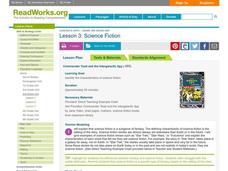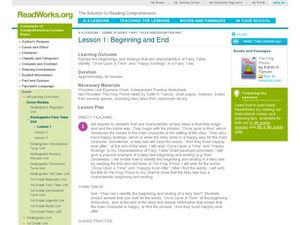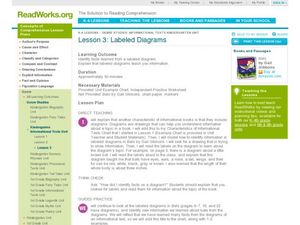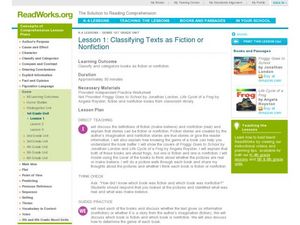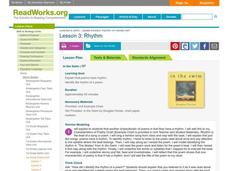Curated OER
Genre: Short Story
Discover the genre of short stories with sixth graders. They discuss the characteristics of short stories from the book America Street. Then, they compare and contrast movies and television shows and chart story characteristics....
Curated OER
Characteristics of Nonfiction
The second lesson in a series from ReadWorks.org, this lesson continues to explore the difference between fiction and nonfiction texts. The lesson opens with the teacher reviewing a class Venn diagram started in the last lesson....
Curated OER
Genre Lesson: What is a Mystery?
Young scholars identify the characteristics of the genre of mystery. In this genre lesson, students discover the elements of a mystery story and begin recording the elements on a class chart of the book entitled Two-Minute...
Curated OER
What is a mystery?
What is a mystery? Learners complete an anagram worksheet to discover the mystery genre. First, they listen as the teacher reads from All About Mysteries and notes defining words on the board. Then they read a mystery and examine it for...
Curated OER
Fantasy
How do you know the book you are reading is a fantasy? Explore the characteristics of the fantasy genre as you read the story Zathura with your class. Together you'll create a class chart that identifies the fantasy genre while building...
Curated OER
Science Fiction
Third graders explore the science fiction genre. In this genres lesson, 3rd graders identify the characteristics of science fiction. Students fill out a chart that shows the characteristics. Students read a selection from a book and talk...
Curated OER
The Rule of Three
What makes a fairy tale a fairy tale? Teach young readers one characteristic that defines the fairy tale genre. They'll learn that events, objects and characters in fairy tales often occur in threes. They read Goldilocks and the Three...
Curated OER
Heroes
Learners read the story of Paul Bunyan and identify the characteristics and actions that make him a hero. In this heroes lesson plan, students explain their answer and draw pictures.
Curated OER
Lesson 3: Labeled Diagrams
Examine the book Stargazers by Gail Gibbons. Young readers will practice reading and interpreting information from diagrams in this informational text. They work together as a class on this skill and then move into independent...
Curated OER
New Information
Young readers explore informational texts as they read a text entitled Giant Pandas by Gail Gibbons. The teacher will begin by explaining that one characteristic of informational texts is that they teach the reader new information...
Curated OER
Lesson 1: Plot Problems
Add another characteristic to your class characteristics of fairy tales chart. First they discuss the concept of problems or conflicts found in most fairy tale plots then they practice identifying conflict as they read. They read...
Curated OER
Lesson 3: Character Values
A value is something a person or character thinks is right or good; it's also a characteristic of a fairy tale. Learners discuss how fairy tale characters often have or exemplify a specific value. They compare the values found in The...
Curated OER
Lesson 1: Beginning and End
Students study fairy tales. In this fairy tales lesson, students discover beginning and ending phrases characteristic of these types of stories. They listen to their teacher read The Frog Prince, take notice of those familiar phrases,...
Curated OER
Labeled Diagrams
Let's learn about bats! Those flying creatures of the night inspire a lesson about non-fiction books. They start by charting characteristics commonly found in informational texts, specifically charts, diagrams, and labels. They look at...
Curated OER
Lesson 1: Classifying Texts as Fiction or Nonfiction
First graders characterize fiction and non-fiction books, they discover the characteristics of each type of book and compare two books (one fiction & one nonfiction) about the same subject. They make a list that describes what...
Curated OER
Explanatory Myths Lesson
A myth is a story that explains something in nature or society. Dive into the study of mythology as you read The Golden Flower with your class. Charts are used to define the characteristics of myths as well as to determine the main point...
Curated OER
Rhythm
One of the most fun characteristics of a poem is rhythm! Little ones will clap along as you read a poem, to determine the rhythm of the piece. The book In the Swim is used throughout the lesson; it contains fish themed poems that kids...
Curated OER
Exaggeration
Learners read the tall tale of Pecos Bill and identify an exaggeration in the story which they state as being part of a tall tale. In this exaggeration lesson plan, students identify the exaggeration by drawing a picture.
Curated OER
Good and Evil Characters
What makes a character good or evil? Young readers discuss the characteristics and actions of good and evil characters in given fairy tales. They then read Snow White and discuss the characters in the story.
Curated OER
Historical Period
Students identify and describe ways in which life was different in the time historical period of Rosa Parks. In this historical time period lesson plan, students explain that one characteristic of a biography is that it takes place in a...
Curated OER
Table of Contents and Index
Have your class investigate the use of a table of contents and index to find information. They identify characteristics of informational books and add them to a chart, then demonstrate how to use the index and table of contents by trying...
Curated OER
Realistic Fiction
Explore the characteristics of realistic fiction by reading and then analyzing the book, Allie’s Basketball Dream by Barbara E. Barber. Using the I do, we do, you do model, learners practice identifying realistic fiction...
Curated OER
Narrative Poetry
Sixth graders explore narrative poetry. In this language arts lesson, 6th graders create a group story. Students discuss the characteristics of narrative poetry and use a story elements checklist to determine which poems are narrative...







